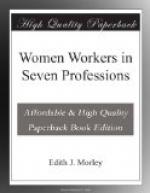These facts explain why it is that local authorities, bent on keeping down the rates, have been enabled to obtain the services of certificated teachers at the scale of salaries which they advertise for uncertificated teachers: in fact many fully qualified certificated teachers have been forced to work for a rate of payment lower than that received by an unskilled labourer; a natural corollary to this condition of things is that many would-be teachers refuse to expend time and money on training.
This state of affairs has had one other effect which is of vital importance when the economic position of women teachers is being considered, namely, that local authorities, in order to appease the popular outcry against this apparently overstocked market, have been led to sanction regulations for the compulsory retirement of women teachers on marriage. Happily the London County Council has not succumbed to this temptation, and there are other equally enlightened authorities. But constant watchfulness is needed in order to prevent retrogression in this matter. Young teachers, anxiously awaiting promotion, sometimes foolishly resist the appointment or retention of married women. This is a suicidal policy, to be resisted at all costs, both in the interests of the teachers and of the children. Salaries are bound to remain low, while women are forced to consider their profession in the light of a stop-gap until marriage, and not as a life-work. Moreover, there are real dangers in entrusting girls’ education entirely to unmarried women. The salaries of assistant teachers vary very considerably. In no single instance is a woman teacher paid the same rate of salary as a man of the same professional status. This is true even when the work is identical in character, as is the case in mixed schools and pupil teachers’ centres. One of the results of this inequality of payment is that women teachers are often employed




